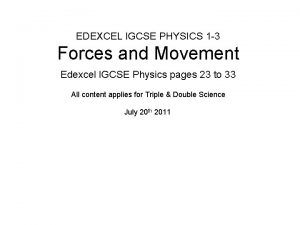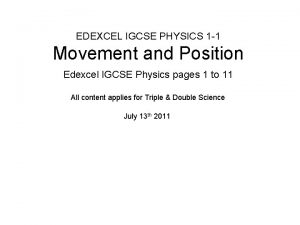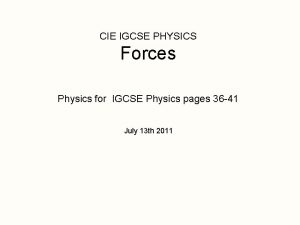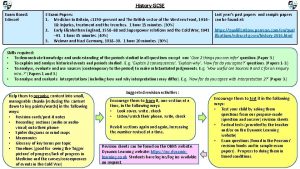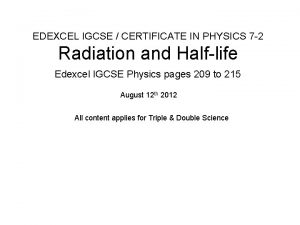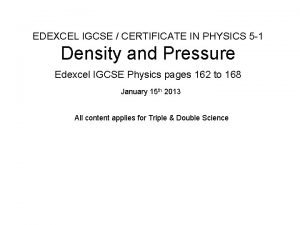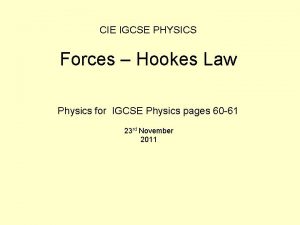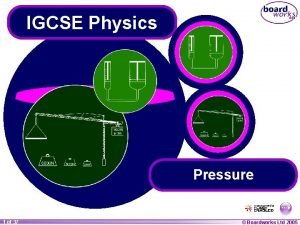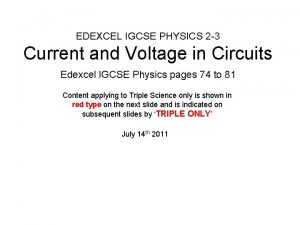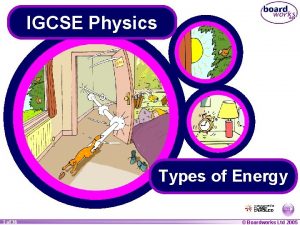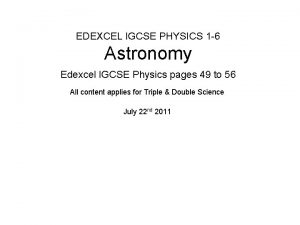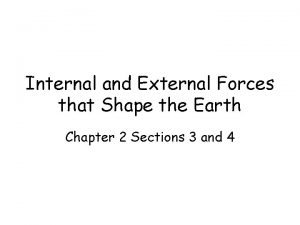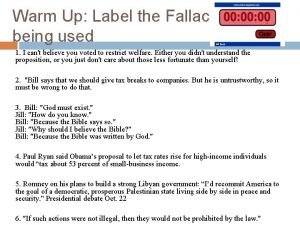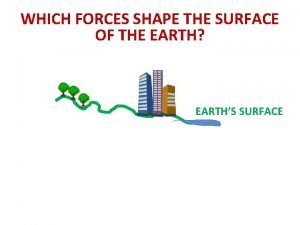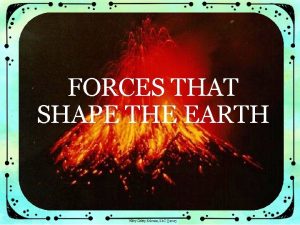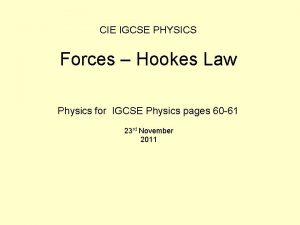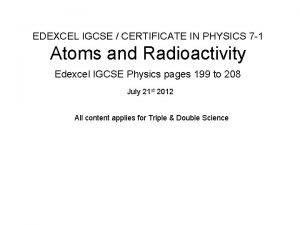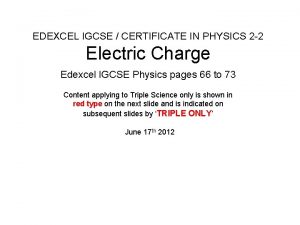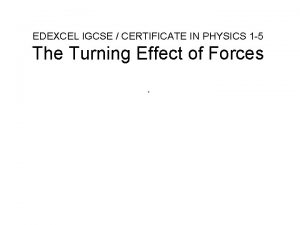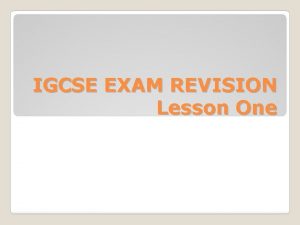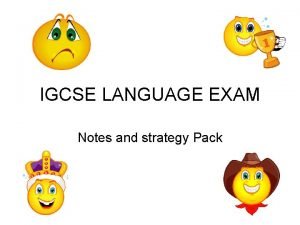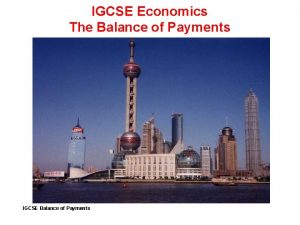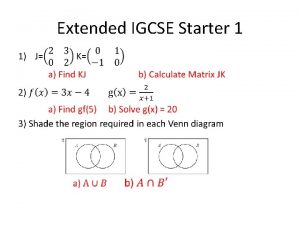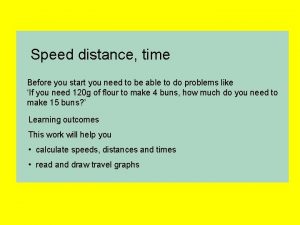EDEXCEL IGCSE PHYSICS 1 2 Forces Shape Edexcel


































- Slides: 34

EDEXCEL IGCSE PHYSICS 1 -2 Forces & Shape Edexcel IGCSE Physics pages 12 to 22 Content applying to Triple Science only is shown in red type on the next slide and is indicated on subsequent slides by ‘TRIPLE ONLY’ July 13 th 2011

Edexcel IGCSE Specification Section 1: Forces and motion c) Forces, movement, shape and momentum express a force as a push or pull of one body on another identify various types of force (for example gravitational, electrostatic etc) distinguish between vector and scalar quantities appreciate the vector nature of a force add forces that act along a line understand that friction is a force that opposes motion describe how extension varies with applied force for helical springs, metal wires and rubber bands recall that the initial linear region of a force-extension graph is associated with Hooke’s law associate elastic behaviour with the ability of a material to recover its original shape after the forces causing deformation have been removed. Red type: Triple Science Only

Force A force is a push or a pull. A force can cause an object to: – speed up – slow down – change direction – change shape Force is measured in newtons (N). Force is measured with a newtonmeters

Some types of force 1. Gravitational This is the attractive force exerted between bodies because of their masses. This force increases if either or both of the masses is increased and decreases if they are moved further apart. Weight is the gravitational force of the Earth on an object. Bathroom scales measure weight. A mass of 1 kg weighs about 10 N 1 stone is about 63 N.

2. Normal reaction or contact This is the repulsive force that stops two touching bodies moving into each other. normal reaction forces The word ’normal’ means that this force acts at 90° to the surfaces of the bodies. weight It is caused by repulsive molecular forces. The two upward reaction forces on the tyres balance the downward weight of the car

3. Friction This is the force that opposes motion. The kinetic energy of the moving object is converted to heat energy by the force of friction. Friction is needed for racing cars to grip the road Friction is needed for walking!

4. Air resistance or drag This is the force that opposes the movement of objects through air. Drag is a more general term used for the opposition force in any gas or liquid. Objects are often streamlined to reduce this force. streamlined car a parachute maximises drag force

5. Upthrust This is the force experienced by objects when they are placed into a fluid (liquid or gas). An object will float on a liquid if the upthrust force equals its weight. A hot air balloon rises when the upthrust from the surrounding air is greater than the balloon’s weight.

6. Magnetic Between magnets but also the force that allows electric motors to work. 7. Electrostatic Attractive and repulsive forces due to bodies being charged. Electrostatic force causes the girls’ hair to rise when they touch the Van der Graaff generator.

Choose appropriate words to fill in the gaps below: A force _____ is a push or a pull. A force can cause an object to accelerate ______ or change shape. newtons (N) with a newtonmeter. Force is measured in _______ contact force occurs when There are many types of force. ____ two bodies touch each other. motion of one body opposes the _______ Friction is a force that _______ attractive forces relative to another. It is caused by the _____ molecules between ______. WORD SELECTION: newtons opposes accelerate force molecules contact attractive motion

TRIPLE ONLY Vectors and Scalars All physical quantities (e. g. speed and force) are described by a magnitude and a unit. VECTORS – also need to have their direction specified examples: displacement, velocity, acceleration, force. SCALARS – do not have a direction examples: distance, speed, mass, work, energy.

TRIPLE ONLY Representing Vectors An arrowed straight line is used. The arrow indicates the direction and the length of the line is proportional to the magnitude. Displacement 50 m EAST Displacement 25 m at 45 o North of East

TRIPLE ONLY Addition of vectors 1 4 N object 4 N 6 N 6 N object resultant = 10 N object The original vectors are called COMPONENT vectors. The final overall vector is called the RESULTANT vector. 4 N 6 N 6 N object 4 N object resultant = 2 N object

TRIPLE ONLY Resultant force A number of forces acting on a body may be replaced by a single force which has the same effect on the body as the original forces all acting together. 2 N This overall force is called resultant force. In the example opposite, 5 N is the resultant force of the 3 N and 2 N forces. 5 N 3 N

TRIPLE ONLY Determine the resultant force in the cases below: 4 N 6 N 10 N 1. 3 N 4. 2. 6 N 4 N 4 N 7 N 2 N 3 N 4 N 1 N 5. 4 N There is no resultant 4 N case force in this

TRIPLE ONLY Resultant force and motion Resultant force Effect on the motion of an object Zero Object’s velocity stays the same including staying stationary Object accelerates In the direction the object is moving In the opposite direction in which the object is moving Object decelerates

TRIPLE ONLY Examples 1 & 2 The box will move when the man’s push force is greater than the friction force. The plane will accelerate provided that the engine force is greater than the drag force.

TRIPLE ONLY Examples 3 & 4 The brakes exert a resultant force in the opposite direction to the car’s motion causing the car to decelerate. Once released, the glider moves at a near constant velocity as it experiences a nearly zero horizontal resultant force.

TRIPLE ONLY Choose appropriate words to fill in the gaps below: resultant force, can be used to replace A single force, called _____ number of forces that act on a body. a _______ zero then the body will either If the resultant force is _____ rest or continue to move at a constant ____. velocity remain at _____ direction as an object’s If the resultant force is in the same _____ motion, the object will _____. A car is decelerated accelerate opposite direction to the when the braking force acts in the _____ car’s motion. WORD SELECTION: number rest direction zero opposite velocity accelerate resultant

Changing shape Force can also change the shape of an object. A stretching force puts an object such as a wire or spring under tension. A squashing force puts an object under compression.

Brittle materials such as glass do not change shape easily and break before noticeably stretching. Resilient materials do not break easily.

Elastic materials return to their original shape when the forces on them are removed. Plastic materials retain their new shape.

Stretching Springs Experimental procedure: 1. Place the weight holder only on the spring and note the position of the pin against the metre rule. 2. Add 1 N (100 g) to the holder and note the new position of the pin. 3. Calculate the extension of the spring. 4. Repeat stages 1 to 3 for 2 N, 3 N, 4 N, 5 N and 6 N. DO NOT EXCEED 6 N. spring weights pin metre rule

Typical results Pin position with holder only (mm) Added weight or Force (N) Pin position with weight (mm) Extension (mm) 450 1 480 30 450 2 509 59 450 3 541 91 450 4 570 120 450 5 601 151 450 6 629 179

Force (N) Force against extension graph 0 0 Extension (mm)

Hooke’s law states that the extension of a spring force is proportional to the force used to stretch the spring. ‘Proportional’ means that if the force is doubled then the extension also doubles. The line on a graph of force against extension will be a straight AND go through the origin.

Question A spring of original length 150 mm is extended by 30 mm by a force of 4 N. Calculate the length of the spring if a force of 12 N is applied. 12 N is three times 4 N Therefore the new extension should be 3 x 30 mm = 90 mm New spring length = 150 mm + 90 mm = 240 mm

Elastic limit Up to a certain extension if the force is removed the spring will return to its original length. The spring is behaving elastically. If this critical extension is exceeded, known as the elastic limit, the spring will be permanently stretched. The right hand spring has been Hooke’s law is no longer obeyed by the stretched beyond its elastic limit spring if its elastic limit is exceeded.

Force (N) Force against extension graph if the elastic limit is exceeded elastic limit 0 0 Extension (mm)

Force Stretching an elastic band An elastic band does not obey Hooke’s law. 0 0 Extension

Choose appropriate words to fill in the gaps below: stretched Hooke’s law states that when a wire or spring is _____ the extension is proportional to the load increase in length or _____ force applied. ______ elastic This law is not obeyed if the spring is taken beyond its ______ permanently limit after which it will become _______ stretched. A ____ rubber band does not obey Hooke’s law. A graph illustrating Hooke’s law will have a line that is straight origin ______ and passes through the _______. WORD SELECTION: stretched elastic permanently extension origin force rubber straight

Online Simulations Effect of forces on motion using a space module Freezeray. com Force combination balloon game - e. Chalk Electric & Magnetic Forces - 'Whys Guy' Video Clip (3: 30 mins) - Shows Charged Balloon & Effect of a magnet on a TV screen. Resultant of two forces - Fendt Forces on objects immersed in liquids - NTNU BBC KS 3 Bitesize Revision: What is a force Balanced forces Unbalanced forces BBC AQA GCSE Bitesize Revision: Resultant force Types of forces Vector Addition - Ph. ET - Learn how to add vectors. Drag vectors onto a graph, change their length and angle, and sum them together. The magnitude, angle, and components of each vector can be displayed in several formats. Representing vectors - e. Chalk Vectors & Scalars - e. Chalk Vector addition - e. Chalk Vector Chains - e. Chalk Fifty-Fifty Game on Vectors & Scalars - by KT Microsoft WORD Vector addition - Explore Science Stretching Springs - Ph. ET - A realistic mass and spring laboratory. Hang masses from springs and adjust the spring stiffness and damping. You can even slow time. Transport the lab to different planets. A chart shows the kinetic, potential, and thermal energy for each spring.

TRIPLE ONLY Forces & Shape Notes questions from pages 4 and 12 to 22 1. 2. 3. 4. 5. 6. 7. (a) What is force? (b) Explain the meaning of the following types of force: gravitational, normal reaction, drag, electrostatic and friction. (see pages 12 to 17) Explain the difference between vectors and scalars quantities and give two examples of each. (see pages 4 and 13) State what is meant by Hooke’s law and explain how a graph can be drawn to verify that a spring obeys this law. What is meant by ‘elastic limit’? Sketch a graph showing how the loading force varies with extension when extending an elastic band. Answer the questions on pages 21 & 22. Verify that you can do all of the items listed in the end of chapter checklist on page 21

DOUBLE ONLY Forces & Shape Notes questions from pages 12 to 22 1. 2. 3. 4. 5. (a) What is force? (b) Explain the meaning of the following types of force: gravitational, normal reaction, drag, electrostatic and friction. (see pages 12 to 17) State what is meant by Hooke’s law and explain how a graph can be drawn to verify that a spring obeys this law. What is meant by ‘elastic limit’? Sketch a graph showing how the loading force varies with extension when extending an elastic band. Answer questions 1, 2, 6 and 9 on pages 21 & 22.
 Igcse physics forces and motion
Igcse physics forces and motion Movement and position physics
Movement and position physics Mains electricity igcse physics
Mains electricity igcse physics Igcse physics forces and motion
Igcse physics forces and motion Young and dyslexic language features
Young and dyslexic language features Young and dyslexic annotations
Young and dyslexic annotations Edexcel history gcse past papers
Edexcel history gcse past papers Edexcel igcse computer science
Edexcel igcse computer science English lit edexcel past papers
English lit edexcel past papers Imaginative writing edexcel igcse
Imaginative writing edexcel igcse Half life formula igcse
Half life formula igcse Igcse physics density and pressure questions
Igcse physics density and pressure questions What is the poem the bright lights of sarajevo about
What is the poem the bright lights of sarajevo about Energy flow diagram physics
Energy flow diagram physics Igcse physics
Igcse physics Igcse physics pressure
Igcse physics pressure Circuit symbols igcse
Circuit symbols igcse Types of energy igcse
Types of energy igcse Igcse physics
Igcse physics Elastic limit graph
Elastic limit graph Example for like parallel force
Example for like parallel force The forces shown above are
The forces shown above are Intramolecular forces vs intermolecular forces
Intramolecular forces vs intermolecular forces Intra vs intermolecular
Intra vs intermolecular Inter vs intramolecular forces
Inter vs intramolecular forces What are some contact forces and some noncontact forces
What are some contact forces and some noncontact forces Balanced forces and unbalanced forces venn diagram
Balanced forces and unbalanced forces venn diagram Is erosion constructive or destructive
Is erosion constructive or destructive Forces that shape the earth
Forces that shape the earth List six forces that shape political socialization
List six forces that shape political socialization External forces that shape the earth
External forces that shape the earth Aerodynamic shapes
Aerodynamic shapes Shape matching and object recognition using shape contexts
Shape matching and object recognition using shape contexts Bolongie
Bolongie Physics 03-06 impulse and momentum answer key
Physics 03-06 impulse and momentum answer key
